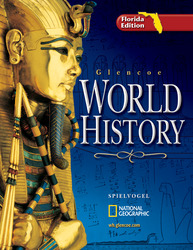Glencoe World History, Florida EditionChapter 10:
Europe in the Middle Ages, 1000–1500Chapter OverviewsIn the early Middle Ages, Europe saw explosive urban growth, a revival of trade, and an emboldened Catholic Church. Yet catastrophic setbacks followed in the form of plague, economic collapse, and war. Christianity remained a focus of European life, but centuries of confrontation with the monarchies left the Church weakened. Section 1 Peasants, Trade, and Cities
The near doubling of Europe's population, combined with more peaceful and settled conditions, contributed to major improvements in life in Europe. Reasons for the change included the development of labor-saving devices, improvements in farming that increased food production, and a revival of trade. Trade, in turn, contributed to the development of a money economy, the resettlement of ancient cities, and the emergence of new cities. Many people still lived as peasants. They combined agricultural and craft work to provide for their families, while turning over part of what they produced to the lord of the manor. The cities, meanwhile, were crowded, dirty places that nevertheless provided new opportunities for men and women. In the cities, guilds regulated employment in many crafts and professions. Section 2 Christianity and Medieval Civilization
A sign of the Church's growing role in European affairs was the Concordat of Worms. By barring monarchs from investing bishops, this document marked a victory for Pope Gregory VII in his bid to reform the Church and assert papal power. The importance of the sacraments for ordinary Christians gave the Church a central role in people's lives. The veneration of saints was also popular and spurred interest in a long list of saints who Christians believed could intercede in heaven on their behalf. Religious fervor prompted new monastic orders to spring up for men and women. The new orders developed an activistic spiritual model. The Inquisition gave the Church a tool for discouraging heresy. Those who failed to do proper penance for heresy could face execution. Section 3 The Culture of the High Middle Ages
The first universities were established in twelfth-century Italy, France, and England as educational guilds. Most students received a liberal arts education. Theology was the most prestigious subject and was heavily influenced by scholasticism. Scholasticism sought to reconcile faith and reason and to harmonize Christian teachings with recently rediscovered works of Greek philosophers. The best-known practitioner of scholasticism was Saint Thomas Aquinas. Although Latin was the universal language of medieval civilization, new literature—mainly poetry—was appearing in regional languages, such as French, English, and Spanish. An eleventh- and twelfth-century building boom produced many new churches. Innovations in architecture made it possible to build soaring Gothic cathedrals, one of the artistic triumphs of the High Middle Ages. Section 4 The Late Middle Ages
Europe's fortunes sank as bubonic plague carried by infested rats decimated Europe's population. In a wave of anti-semitism, many people attacked Jews, accusing them of causing the plague by poisoning the wells. The plague devastated Europe's economy as well and accelerated the end of serfdom. Church power declined as European kings rejected papal claims of supremacy. Popular respect for the papacy was undermined by the Great Schism, a nearly forty-year papal crisis during which a rival papacy was set up in France. The Hundred Years' War introduced new methods of warfare, adding to the problems of the late Middle Ages. The "new monarchies" of the fifteenth century reestablished the centralized power of the monarchies in England, France, and Spain.  | 

















